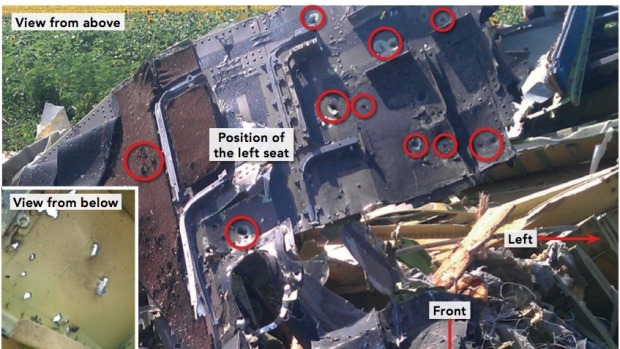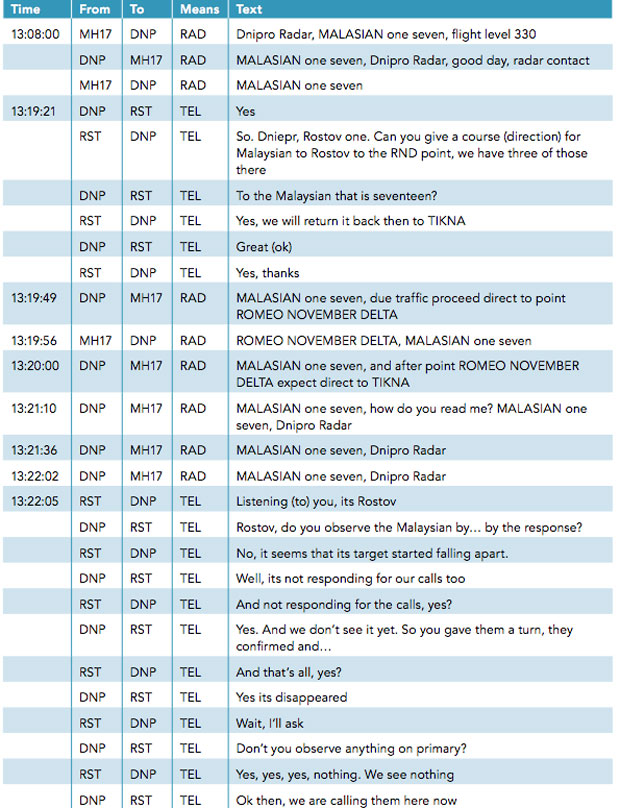
After the final communication from the plane (a simple acknowledgement of "Romeo November Delta, Malaysian one seven"), a few minutes later flight controllers in Dnipro and Rostov talk on the phone trying to locate the flight.
"Do you observe the Malaysian," Dnipro asks.
"No, it seems that its target started falling apart," Rostov responds.
"It's not responding for our calls too," Dnipro says. "It's disappeared."
Moments earlier, the report finds, a large number of high-energy objects smashed through flight MH17, causing it to break up in mid-air and crash in eastern Ukraine.
There was no distress message and no sign of any technical fault or pilot error, according to the Dutch Safety Board.
This impact caused the plane to break up in mid-air, according to the Dutch Safety Board.
All 298 people on board MH17 died in the crash, including 27 Australian citizens.
"Multiple holes and indentations" were found in wreckage from the cockpit and forward section of the plane.
A part of the cockpit roof also showed holes indicating the plane was penetrated from the outside.
"Material around the holes was deformed in a manner consistent with being punctured by high-energy objects [which] originated from outside the fuselage.
"The pattern of damage observed in the forward fuselage and cockpit section of the aircraft was consistent with the damage that would be expected from a large number of high-energy objects that penetrated the aircraft from outside."
The aircraft broke up in the air, with some parts continuing down and forward before breaking up further.
The black box recording from the cockpit ended abruptly with no sign of alarm, the report found.
"No aural warnings or alerts of aircraft system malfunctions were heard on the cockpit voice recording, which ended at 13.20:03 hrs," the report said. "Crew communication gave no indication that there was anything abnormal with the flight."
The engines were running normally at cruise power until the data recording stopped.
According to the report, MH17's flight plan was approved by all the usual air-traffic control centres.
The plane changed course over Ukraine to avoid thunderstorms.
The Dutch Safety Board is taking the lead in the investigation, assisted by experts from Australia, Britain, Germany, Malaysia, the US, Ukraine and Russia.
The investigation covers the cause of the crash, the decision-making around flight routes and the availability of passenger lists.
Experts looked at photographs from the crash site, satellite images and the data recorders (black boxes). The flight recorder was slightly damaged in the crash but the memory module was intact, all 30 minutes of data were recovered and there was no evidence it had been tampered with.
The investigation was hampered because the flight came down in separatists' territory in eastern Ukraine, close to areas of heavy fighting.
Investigators were only able to make a few short visits to the crash site in late July, to take photographs of the wreckage.
The safety board's investigation into MH17 will continue "unabated" after the preliminary report, the Dutch Safety Board said.
The investigation may also include a return to the crash site.
On Monday Malaysia's Defence Minister Hishamuddin Hussein said he had agreed "in principle" with Ukraine that an international team of personnel from Australia, the Netherlands and Malaysia "should gain early safe access into the MH17 crash site".
However Mr Hussein said he had received a briefing from the chief of Ukraine's army that the crash side is "currently volatile and inaccessible".
The Dutch Safety Board said the information in the preliminary report was "tentative" and could change with further evidence.
The board's final report is expected within a year.
Crash investigators are unlikely to identify the source of the "high-energy objects" that downed the plane.




Comment: Translation: Crash investigators will be blocked or censored from identifying the source because it would reveal the plane was downed in a hail of cannon-fire from an Israeli-upgraded Scorpion Su-25 fighter jet, followed by a bomb planted at Schiphol Airport to ensure no one survived.
See also the Russian Union of Engineers report on MH17.